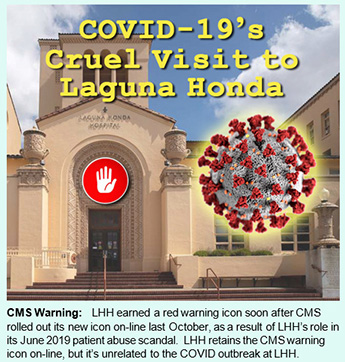 Printer-friendly PDF file
Printer-friendly PDF fileJuly 2020
Hiding Data Is Ineffective Against This Virus
COVID-19's Cruel Visit to Laguna Honda
 Printer-friendly PDF file
Printer-friendly PDF file
July 2020
Hiding Data Is Ineffective Against This Virus
COVID-19's Cruel Visit to Laguna Honda
by Patrick Monette-Shaw
As the saying goes, transparency and accountability go hand in hand. Hiding data from transparency is clearly no strategy to combat the cruel morbidity and mortality caused by COVID-19.
I wasn’t surprised when both Mayor London Breed and Governor Gavin Newsom reversed course over the June 27 weekend and rolled back their premature re-opening plans for the state and The City. After all, neither of them have been very transparent about COVID in nursing homes in the City and across the state.
Since COVID-19 surfaced across the world four months ago San Francisco’s Department of Public Health (SFDPH) has refused to report the number of COVID infections among staff and patients in each of San Francisco’s 21 skilled nursing facilities (SNF’s) on its public-facing web site. That’s not transparency. It’s dereliction.
 Similarly, California’s Department of Public Health (CDPH) has refused to report accurately the number of staff and patient COVID infections in each of California’s 1,224 SNF’s on its public web site. That’s not transparency, either. More dereliction of duty. SNF’s are required to report each new COVID case to CDPH within one to two hours. Promptly releasing and posting the full data to CDPH’s web site — without “scrubbing” the data — should be relatively quick and easy.
Similarly, California’s Department of Public Health (CDPH) has refused to report accurately the number of staff and patient COVID infections in each of California’s 1,224 SNF’s on its public web site. That’s not transparency, either. More dereliction of duty. SNF’s are required to report each new COVID case to CDPH within one to two hours. Promptly releasing and posting the full data to CDPH’s web site — without “scrubbing” the data — should be relatively quick and easy.
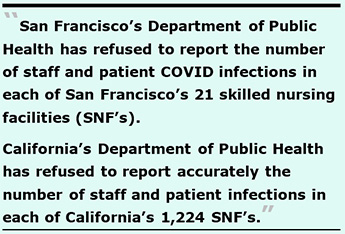 Rather than reporting aggregated data for each facility, CDPH creatively obscures facility-level data by “de-identifying” cases — reporting only “<11” for facilities having fewer than 11 cases of staff or patient COVID infections. CDPH claims it does so to comply with the Health Insurance Portability and Accountability Act (HIPAA), the federal health privacy law that protects individual patient’s data. The HIPAA claim is just a pretext to avoid disclosing crucial data. There’s nothing in HIPAA that prohibits releasing aggregate data that doesn’t include patient identifiers, so hiding behind HIPAA is bogus precisely because there’s no way on earth to identify individual patient names from aggregated data.
Rather than reporting aggregated data for each facility, CDPH creatively obscures facility-level data by “de-identifying” cases — reporting only “<11” for facilities having fewer than 11 cases of staff or patient COVID infections. CDPH claims it does so to comply with the Health Insurance Portability and Accountability Act (HIPAA), the federal health privacy law that protects individual patient’s data. The HIPAA claim is just a pretext to avoid disclosing crucial data. There’s nothing in HIPAA that prohibits releasing aggregate data that doesn’t include patient identifiers, so hiding behind HIPAA is bogus precisely because there’s no way on earth to identify individual patient names from aggregated data.
Now four months into the global COVID-19 pandemic, San Franciscans and Californians have gotten little transparency from either Mayor Breed or Governor Newsom about COVID cases in SNF’s, and have received even less accountability from either elected official.
COVID Visits San Francisco SNF’s
 Breed had announced on May 6 that San Francisco hadn’t flattened its COVID curve. Data posted to the San Francisco Department of Public Health’s COVID-19 Tracker web site documented that in the week ending May 9, the City reported 341 new positive cases, the highest weekly case total since March 7 when data collection began.
Breed had announced on May 6 that San Francisco hadn’t flattened its COVID curve. Data posted to the San Francisco Department of Public Health’s COVID-19 Tracker web site documented that in the week ending May 9, the City reported 341 new positive cases, the highest weekly case total since March 7 when data collection began.
Breed knew that record was shattered in the week ending June 27 when total weekly cases soared to 503, pushing total cumulative positive cases to 3,561. The increase in weekly cases was due, in part, to COVID cases at Laguna Honda Hospital that rose from 7 cases on March 26, to 29 cases on May 18, to 83 cases as of June 28 according to CMS. Those increases occurred long after LHH was shut down to visitors on March 6 when the facility was essentially quarantined.
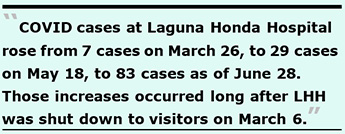 Breed also knew San Francisco had six additional COVID-related deaths citywide during the 14-day period ending June 27, over 10 percent of the City’s then 50 total COVID-related deaths.
Breed also knew San Francisco had six additional COVID-related deaths citywide during the 14-day period ending June 27, over 10 percent of the City’s then 50 total COVID-related deaths.
For Newsom’s part, he had to have known that in the one-week period ending June 27, California reported an additional 35,567 COVID-19 cases, an average of over 5,000 new cases each day. Newsom also had to have known that in the same one-week period ending June 27, California had 406 additional COVID-related deaths statewide.
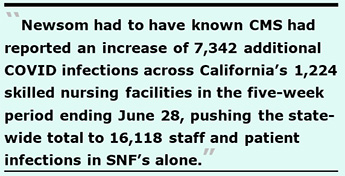 Finally, Newsom had to have known that CMS had reported an increase of 7,342 additional COVID-positive infections among staff and residents across California’s 1,224 skilled nursing facilities across the five-week period ending June 28, pushing the statewide total to 16,118 staff and patient infections in skilled nursing facilities alone.
Finally, Newsom had to have known that CMS had reported an increase of 7,342 additional COVID-positive infections among staff and residents across California’s 1,224 skilled nursing facilities across the five-week period ending June 28, pushing the statewide total to 16,118 staff and patient infections in skilled nursing facilities alone.
No wonder both Breed and Newsom reversed course on premature re-opening: The COVID curve in the state hasn’t been “crushed,” let alone “flattened,” particularly not in skilled nursing facilities and other congregate settings, like prisons.
Reviewing the timeline is instructive:
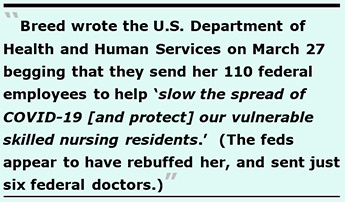 The next day, when LHH’s COVID cases stood at seven cases, Breed wrote the U.S. Department of Health and Human Services on March 27 begging that they send her 110 federal employees to help “slow the spread of COVID-19 [and protect] our vulnerable skilled nursing residents” at Laguna Honda and other skilled nursing facilities in San Francisco. (The feds appear to have rebuffed her, and sent just six federal doctors; Breed’s office claims she received no written response from DHHS.)
The next day, when LHH’s COVID cases stood at seven cases, Breed wrote the U.S. Department of Health and Human Services on March 27 begging that they send her 110 federal employees to help “slow the spread of COVID-19 [and protect] our vulnerable skilled nursing residents” at Laguna Honda and other skilled nursing facilities in San Francisco. (The feds appear to have rebuffed her, and sent just six federal doctors; Breed’s office claims she received no written response from DHHS.)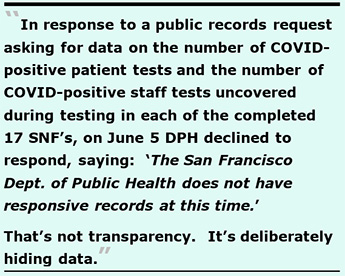 On June 2, news surfaced that the Department of Public Health (DPH) had informed the Health Commission that DPH had completed universal COVID-19 testing in 17 of the 21 Skilled Nursing Facilities (SNF’s) in San Francisco.
On June 2, news surfaced that the Department of Public Health (DPH) had informed the Health Commission that DPH had completed universal COVID-19 testing in 17 of the 21 Skilled Nursing Facilities (SNF’s) in San Francisco. CMS Comes to the Rescue
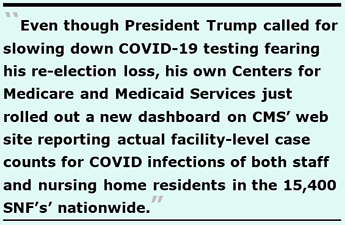 Since at least last May, President Trump has successively claimed “If we didn’t do any testing, we would have very few [COVID] cases,” as if there would be no cases if there were no testing to detect new cases. As if!
Since at least last May, President Trump has successively claimed “If we didn’t do any testing, we would have very few [COVID] cases,” as if there would be no cases if there were no testing to detect new cases. As if!
That’s among the many reasons why observers believe the federal government has been derelict in its nursing home coronavirus response duties.
A month later Trump beat the same drum on June 15, claiming “If we stop testing right now, we’d have very few cases, if any.” Less than a week later, Trump claimed in Tulsa on June 20, “When you do testing to that extent, you’re going to find more people; you’re going to find more cases. So, I said to my people, ‘Slow the testing down, please’.”
That was after Trump’s administration called on May 12 that expanded testing of all nursing home staff and residents be conducted by the end of May.
Luckily, CMS came to the rescue, so we are now getting a modicum of facility-level data of COVID infections in SNF’s1.
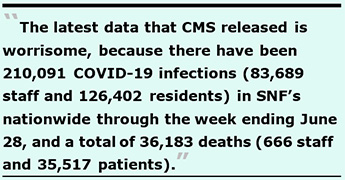 Even though President Trump had called for slowing down COVID-19 testing nationwide fearing his re-election loss, his own Centers for Medicare and Medicaid Services (CMS) under its administrator Seema Verma just rolled out a new dashboard on CMS’ web site reporting actual facility-level case counts for COVID infections of both staff and nursing home residents in the 15,400 SNF’s’ nationwide, including in San Francisco and California. All SNF’s nationwide are now required to submit weekly update reports electronically to CMS.
Even though President Trump had called for slowing down COVID-19 testing nationwide fearing his re-election loss, his own Centers for Medicare and Medicaid Services (CMS) under its administrator Seema Verma just rolled out a new dashboard on CMS’ web site reporting actual facility-level case counts for COVID infections of both staff and nursing home residents in the 15,400 SNF’s’ nationwide, including in San Francisco and California. All SNF’s nationwide are now required to submit weekly update reports electronically to CMS.
Unfortunately, there’s an 11-day lag between when facilities have to report the data before CMS finally posts it on-line. The data for the first week ending May 24 became available on-line around June 4. So far, CMS has published a total of six reports. The latest data that CMS released is worrisome, because in the 15,400 nursing homes nationwide there have been 210,091 COVID-19 infections (83,689 staff and 126,402 residents) through the week ending June 28, and a total of 36,183 deaths (666 staff and 35,517 patients).
CMS’ Nursing Home Data for San Francisco
Because both SFDPH and CDPH chose to avoid transparency by not releasing facility-level COVID data for staff and residents of SNF’s, we were extremely lucky to have gotten any facility-level data out of the new CMS web site.
Table 1: COVID-19 Cases in San Francisco Skilled Nursing Facilities as of June 28, 2020 per CMS
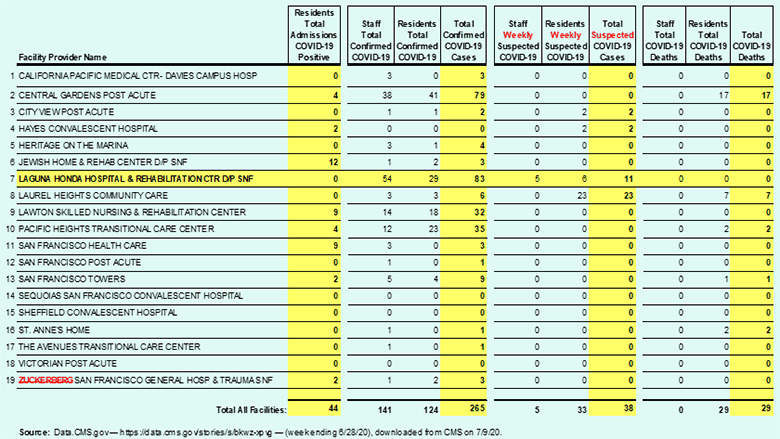
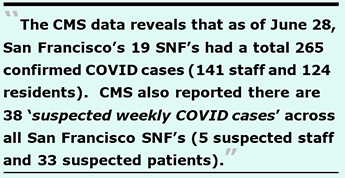 The CMS data reveals that as of June 28, San Francisco’s 19 SNF’s had a total 265 confirmed COVID cases (141 staff and 124 residents), up 105 cases since CMS’s first report for the week ending May 24 when there was a total of 160 confirmed COVID cases across all San Francisco SNF’s, plus a total of 18 deaths (all patients, not staff). As of June 28, patient deaths increased to 29. The CMS data for June 28 also reported there are 38 “suspected weekly COVID cases” across all San Francisco SNF’s (5 suspected staff and 33 suspected patients) that may, or may not, convert to confirmed cases in coming weeks.
The CMS data reveals that as of June 28, San Francisco’s 19 SNF’s had a total 265 confirmed COVID cases (141 staff and 124 residents), up 105 cases since CMS’s first report for the week ending May 24 when there was a total of 160 confirmed COVID cases across all San Francisco SNF’s, plus a total of 18 deaths (all patients, not staff). As of June 28, patient deaths increased to 29. The CMS data for June 28 also reported there are 38 “suspected weekly COVID cases” across all San Francisco SNF’s (5 suspected staff and 33 suspected patients) that may, or may not, convert to confirmed cases in coming weeks.
As for Laguna Honda, the CMS data reveals that as of June 28, LHH had a total of 83 confirmed cases (54 staff and 29 patients), up from a total of 66 cases on May 24. The 54 staff cases at LHH represents 38% of the 141 staff infections across all 19 San Francisco SNF’s. The CMS data for the week ending June 28 also reported there are an additional 11 “suspected weekly COVID cases” at LHH (5 staff and 6 patients) that may, or may not, also convert to confirmed cases in coming weeks.
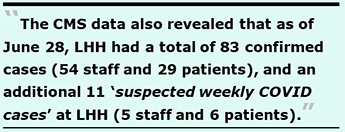 Both Breed, SFDPH, and San Francisco’s Health Commission knew this data as early as June 2 when SFDPH informed the Health Commission that 17 of San Francisco’s 21 SNF’s had completed universal baseline testing of all patients and staff. (Note: It is thought that San Francisco is including two SNF’s that the City may utilizing but are located outside of the City, whereas CMS only counts San Francisco as having a total of 19 SNF’s.)
Both Breed, SFDPH, and San Francisco’s Health Commission knew this data as early as June 2 when SFDPH informed the Health Commission that 17 of San Francisco’s 21 SNF’s had completed universal baseline testing of all patients and staff. (Note: It is thought that San Francisco is including two SNF’s that the City may utilizing but are located outside of the City, whereas CMS only counts San Francisco as having a total of 19 SNF’s.)
The CMS reports showed that as of June 28, the 1,224 SNF’s across California reported 16,118 confirmed COVID cases (6,801 staff and 9,317 patients), an increase of 7,342 confirmed cases across the five weeks since CMS first released data for the week ending May 24. The CMS data for June 28 also reported there are 1,271 “suspected weekly COVID cases” in all SNF’s across the state that may, or may not, convert to confirmed cases in coming weeks.
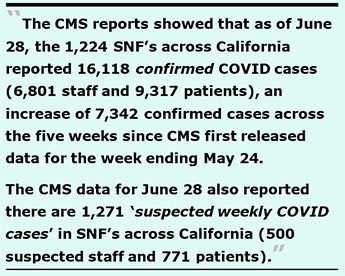 Discrepancies Between CDPH and CMS’ Nursing Home Data
Discrepancies Between CDPH and CMS’ Nursing Home Data
Comparing the COVID data posted on CDPH’s web site to data posted on CMS’s new web site revealed additional problems with the accuracy of the data. CMS reported far fewer confirmed cases and deaths in California SNF’s than did CDPH.
The number of patient and staff deaths in SNF’s statewide differ by 361 deaths (CMS reported a total of 2,190 staff and patient deaths in California SNF’s through June 28, whereas data on CDPH’s web site for June 28 reported 2,551 deaths).
Beyond deaths, the discrepancy of confirmed COVID positive infections reported by the two agencies differed remarkably.
CMS’s web site reported 16,118 confirmed COVID cases across California (6,801 staff and 9,317 residents) as of June 28, but CDPH’s web site reported a total of 21,973 confirmed cases (8,570 staff and 13,403 patients) as of June 28, a difference of 5,855 total confirmed cases in California SNF’s. It’s not known why the data reported by each SNF directly to CDPH is considerably higher than the data reported to CMS, and whether the discrepancy is due to President Trump wanting CMS to “slow down” the testing and positive test results numbers nationwide. Nor is it known whether future reports to CMS will clear up the 5,855 case disparity between data from CMS vs. data from CDPH for California SNF’s.
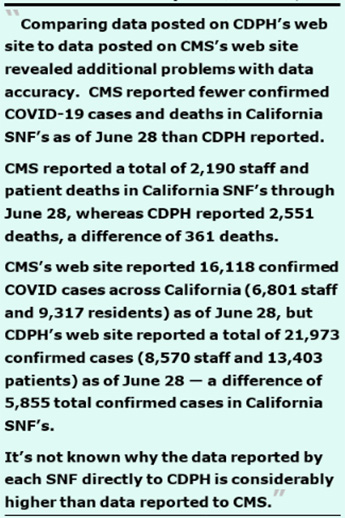 Unfortunately, neither the CMS or CDPH web sites include confirmed case counts or deaths that have occurred in Residential Care Facilities for the Elderly (RCFE’s) and other types of assisted living facilities; both of the two sites report data only for California SNF’s.
Unfortunately, neither the CMS or CDPH web sites include confirmed case counts or deaths that have occurred in Residential Care Facilities for the Elderly (RCFE’s) and other types of assisted living facilities; both of the two sites report data only for California SNF’s.
California’s Department of Social Services (CDSS), which licenses RCFE’s in California, does post on-line separate data for COVID cases and deaths in RCFE’s and Adult Residential Facilities (ARF’s). Unfortunately, it doesn’t appear that there is a web site that reports how many COVID infections and deaths have occurred in RCFE’s and ARF’s nationwide.
CDSS reported there were an additional 3,416 confirmed staff and resident COVID infections in RCFE’s and ARF’s, pushing the total from 21,973 confirmed COVID cases only in SNF’s to 25,389 confirmed COVID cases statewide as of June 28.
Similarly, there were an additional 430 staff and patient deaths in RCFE’s and ARF’s, which pushed the death toll from 2,551 in only SNF’s to a total of 2,981 deaths across the various types of elder care facilities statewide in California as of June 28.
In addition to confirmed COVID cases in SNF’s nationwide, CMS additionally requires SNF’s to report weekly counts of suspected COVID infections of both staff and patients. CMS allowed SNF’s to report “suspected” COVID cases on their initial May 24 weekly reports to include cumulative suspected cases back to January 1, 2020 but subsequent weekly reports were to include only suspected cases for the then current week. Presumably, the weekly reports going forward now include only projected “suspected” cases for a one-week period.
Breed Avoids Transparency and Accountability
Since there has been next to no transparency regarding the actual number of COVID infections in nursing homes across the United States, it’s not too surprising that Mayor Breed chose to avoid accountability by dodging full transparency.
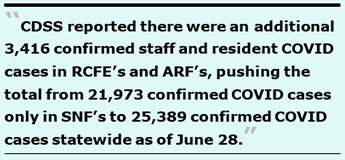 Sadly, Mayor Breed and her office failed to respond to multiple requests for comment regarding COVID-19 outbreaks in San Francisco’s nursing homes:
Sadly, Mayor Breed and her office failed to respond to multiple requests for comment regarding COVID-19 outbreaks in San Francisco’s nursing homes:
 CMS had been reporting a total of 18 COVID-related deaths in San Francisco SNF’s since CMS’s first report for the week ending May 24 was posted on-line; that rose to a total of 29 deaths across all San Francisco SNF’s on June 28 when the Central Gardens Post Acute SNF finally reported 17 patient deaths to CMS six weeks after CMS began requiring data submission. Neither Breed, Colfax, nor Aragón have even bothered to mention to date those 29 deaths in San Francisco nursing homes (although SFDPH’s COVID-19 Tracker web site does publish cumulative deaths data, it doesn’t report where those deaths occurred). The 29 deaths across San Francisco SNF’s represents 58% of the City’s 50 COVID-related deaths reported as of June 28.
CMS had been reporting a total of 18 COVID-related deaths in San Francisco SNF’s since CMS’s first report for the week ending May 24 was posted on-line; that rose to a total of 29 deaths across all San Francisco SNF’s on June 28 when the Central Gardens Post Acute SNF finally reported 17 patient deaths to CMS six weeks after CMS began requiring data submission. Neither Breed, Colfax, nor Aragón have even bothered to mention to date those 29 deaths in San Francisco nursing homes (although SFDPH’s COVID-19 Tracker web site does publish cumulative deaths data, it doesn’t report where those deaths occurred). The 29 deaths across San Francisco SNF’s represents 58% of the City’s 50 COVID-related deaths reported as of June 28. Breed failed to comment on why San Francisco DPH’s COVID-19 Data Tracker web site contains no information whatsoever on any of its various sub-pages about COVID cases and data in San Francisco’s SNF’s.
Breed failed to comment on why San Francisco DPH’s COVID-19 Data Tracker web site contains no information whatsoever on any of its various sub-pages about COVID cases and data in San Francisco’s SNF’s.We aren’t done seeing the devastation from COVID. We’re not even close to seeing the end. Pausing the re-opening is justified, if for no other reason than because the worst yet to come is nowhere near. Surely Breed and Newsom know this.
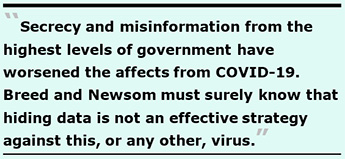 Secrecy and misinformation from the highest levels of government have worsened the affects from COVID-19. Breed and Newsom must surely know that hiding data is not an effective strategy against this, or any other, virus.
Secrecy and misinformation from the highest levels of government have worsened the affects from COVID-19. Breed and Newsom must surely know that hiding data is not an effective strategy against this, or any other, virus.
Forbes was right: The most important statistic is that well over 42% of COVID-related deaths in the U.S. have come from the 0.6% of the nation’s population living in nursing homes. None of these lives were “disposable” or “expendable.”
We must ask ourselves: “How much worse will COVID-19’s cruelty in skilled nursing homes get before it gets better?” We should also ask Breed and Newsom, “Why can’t you produce truly transparent COVID-in-nursing-home data?”
 As for the moron2 in the Oval Office, he claimed over the Fourth of July weekend that over 99% of COVID cases are “totally harmless.” I have two words for Trump: Nick Cordero. Cordero was the 41-year-old Broadway actor who died on July 5 after he endured amputation of his right leg following testing positive for COVID-19. Cordero’s wife noted he was faced needing a double lung transplant since his lungs had been so severely damaged.
As for the moron2 in the Oval Office, he claimed over the Fourth of July weekend that over 99% of COVID cases are “totally harmless.” I have two words for Trump: Nick Cordero. Cordero was the 41-year-old Broadway actor who died on July 5 after he endured amputation of his right leg following testing positive for COVID-19. Cordero’s wife noted he was faced needing a double lung transplant since his lungs had been so severely damaged.
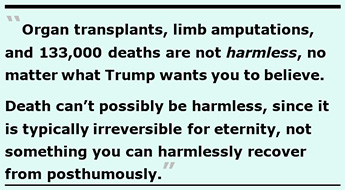 Limb amputations and organ transplants are not what reasonable people who are not morons would define as being “harmless.” Only if you’re a moron would organ transplants and amputations — or eventual death — be considered harmless. After all, death can’t possibly be harmless, since it is typically irreversible for eternity, not something you can harmlessly recover from, even if you’re embalmed in a bucket of hydroxychloroquine. Or administered it posthumously.
Limb amputations and organ transplants are not what reasonable people who are not morons would define as being “harmless.” Only if you’re a moron would organ transplants and amputations — or eventual death — be considered harmless. After all, death can’t possibly be harmless, since it is typically irreversible for eternity, not something you can harmlessly recover from, even if you’re embalmed in a bucket of hydroxychloroquine. Or administered it posthumously.
Trump’s claim that 99% of COVID cases are harmless is comical for another reason: Despite attending Wharton Business School as a very stable genius, this moron doesn’t appear to understand that the three million COVID cases diagnosed to date nationwide as of July 7 have already resulted in over 133,000 deaths. Those deaths represent 4.3% of the three million known cases, so there’s no way in math hell to claim 99% of the cases are harmless when over 4% of the cases resulted in death. (Unless of course, you define death as being harmless.)
Please see a companion piece on this web site published in June as an historical summary of the first four months of the COVID pandemic nationwide, in California, and in San Francisco.
Monette-Shaw is a columnist for San Francisco’s Westside Observer newspaper, and a member of the California First Amendment Coalition (FAC) and the ACLU. He operates stopLHHdownsize.com. Contact him at monette-shaw@westsideobserver.com.
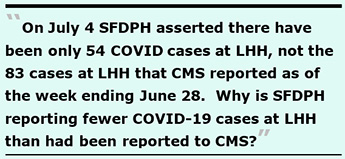 Addendum
Addendum
On June 16, a records request was submitted to Dr. Colfax, San Francisco’s Director of Public Health, seeking clarification on why data for the week ending May 31 posted on CMS’s web site had reported a total of 66 COVID infections between staff and residents at LHH, but subsequent data posted on CDPH’s web site on June 15 reported a total of just 48 cases at LHH. Again, why are CMS, CDPH, and SFDPH reporting conflicting data about the cumulative number of COVID-19 cases at LHH?
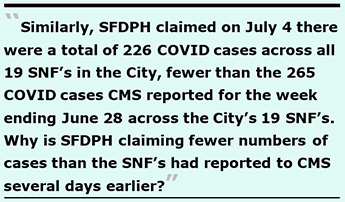 On July 4, Zoe Harris, LHH’s public information officer, responded on behalf of DPH. Her response deepened the disconnect in case reporting across agencies. Harris reported there have been only 54 COVID cases at LHH as of July 2, not the 66 cases at LHH that CMS had reported for the week ending May 31, and not the 83 cases at LHH that CMS reported for the week ending June 28. That prompted asking why SFDPH was reporting fewer COVID-19 cases at LHH than had been reported to CMS. (Ms. Harris is a City contractor, not a City employee).
On July 4, Zoe Harris, LHH’s public information officer, responded on behalf of DPH. Her response deepened the disconnect in case reporting across agencies. Harris reported there have been only 54 COVID cases at LHH as of July 2, not the 66 cases at LHH that CMS had reported for the week ending May 31, and not the 83 cases at LHH that CMS reported for the week ending June 28. That prompted asking why SFDPH was reporting fewer COVID-19 cases at LHH than had been reported to CMS. (Ms. Harris is a City contractor, not a City employee).
Harris also reported that as of July 1 there were a total of 226 COVID-19 cases across all SNF’s in the City, fewer than the CMS data for the week ending June 28 that had reported 265 COVID cases across the 19 SNF’s. Why is SFDPH claiming fewer numbers of cases across the 19 SNF’s than the SNF’s had ostensibly reported themselves to CMS several days earlier?
Finally, Harris indicated there have only been 16 COVID-related deaths across San Francisco’s 19 SNF’s as of July 1, not the 18 deaths that CMS has been consistently reporting since its first report for the week ending May 24.
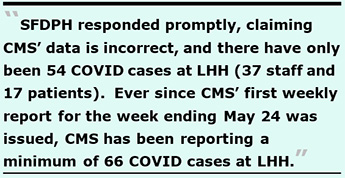 When these discrepancies were pointed out to Ms. Harris, she claimed on July 6 she’d research the issue.
When these discrepancies were pointed out to Ms. Harris, she claimed on July 6 she’d research the issue.
LHH Asserts CMS Data Error
Just before uploading this completed article to my web site, I circled back asking Ms. Harris on July 10 whether she had made any progress clearing up the LHH case count discrepancy.
Harris responded promptly, claiming CMS’ data is incorrect. She wrote:
“We have followed-up with CMS and are working to correct the data in CMS’ database for LHH as it is incorrect. Thank you for bringing this to our attention. We never had 80 cases, 54 [is] correct (37 staff and 17 patients).”
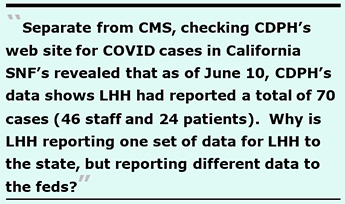 Why did it take DPH from June 16 when I placed the records request to July 10 before it figured out CMS may be reporting inaccurate data for LHH?
Why did it take DPH from June 16 when I placed the records request to July 10 before it figured out CMS may be reporting inaccurate data for LHH?
What’s totally sad, of course, is that ever since CMS’ first weekly report for the week ending May 24 was issued CMS has been reporting a minimum of 66 COVID cases at LHH.
Separate from CMS, checking CDPH’s web site for COVID cases in California SNF’s revealed that also as of June 10, CDPH’s data shows LHH had reported a total of 70 cases (46 staff and 24 patients). Why is LHH reporting one set of data for LHH to the state, but reporting different data to the feds? How did CMS and CDPH both get ahold of incorrect LHH data?
It’s too bad that it takes a retired private citizen like me to ask tough questions before LHH reached out to CMS to correct potentially inaccurate data. It’s as if there are no efforts by City agencies to monitor whether data they have submitted is being reported accurately, without citizen’s getting involved. CMS has released six weekly reports. Can I have been the only person to have noticed? It should not have been me bringing this to the attention of LHH, or for that matter, to Breed or to Colfax.
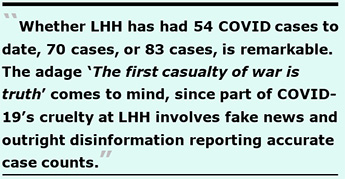 Whether LHH has had 54 COVID cases to date, or 70 cases, or 83 cases, is remarkable, in part, because LHH’s case counts haven’t been accurately or transparently reported to San Franciscans since at least mid-May. The adage ‘The first casualty of war is truth’ comes to mind, since part of COVID-19’s cruelty at LHH involves fake news and outright disinformation reporting accurate case counts.
Whether LHH has had 54 COVID cases to date, or 70 cases, or 83 cases, is remarkable, in part, because LHH’s case counts haven’t been accurately or transparently reported to San Franciscans since at least mid-May. The adage ‘The first casualty of war is truth’ comes to mind, since part of COVID-19’s cruelty at LHH involves fake news and outright disinformation reporting accurate case counts.
CMS’ Warning Icon
A reminder about CMS’ warning icon is in order. Reader’s may recall I published “LHH Leadership Fingered in Patient Abuse Scandal” in December 2019 shortly after news of CMS’ warning icon first appeared.
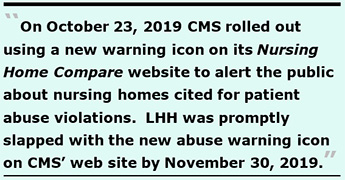 On October 23, 2019 CMS rolled out using a new warning icon on its Nursing Home Compare website to alert the public about nursing homes cited for patient abuse violations. The new warning icon — shown in the illustration at the top of this article on the front door of LHH — was designed to appear next to the names of SNF’s given citations for abuse that lead to harm of a nursing home resident within the past year, or was cited for abuse that could have potentially led to resident harm in each of the two previous years.
On October 23, 2019 CMS rolled out using a new warning icon on its Nursing Home Compare website to alert the public about nursing homes cited for patient abuse violations. The new warning icon — shown in the illustration at the top of this article on the front door of LHH — was designed to appear next to the names of SNF’s given citations for abuse that lead to harm of a nursing home resident within the past year, or was cited for abuse that could have potentially led to resident harm in each of the two previous years.
LHH was promptly slapped with the new abuse warning icon on CMS’ web site by November 30, 2019 for the patient abuse scandal that rocked LHH in June 2019. The icon remains on CMS’ web site as of July 6. (The icon is not actually posted on LHH’s front door — shown in the illustration for this article — as a warning to visitors to hospital, but it should be.)
Figure 1 is a screen capture taken from CMS’ web site on Saturday, July 4 still showing the red warning icon clearly visible next to LHH’s name.
Figure 1: CMS Nursing Home Compare Rating of LHH (as of July 4, 2020)
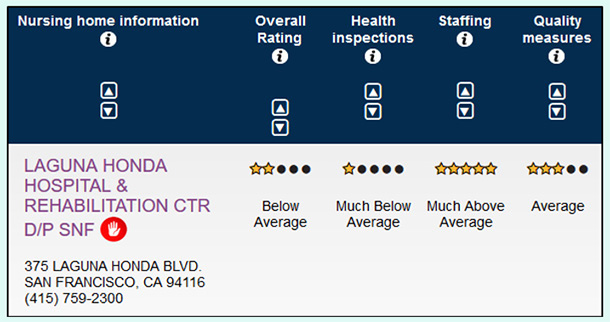
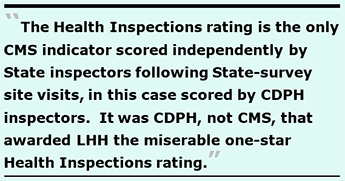 Note that Figure 1 shows LHH’s most recent Health Inspections score is a one-star rating, representing “much below average.” As I reported last December, the Health Inspections rating is not determined by CMS based on self-reporting of indicators submitted by each facility to CMS.
Note that Figure 1 shows LHH’s most recent Health Inspections score is a one-star rating, representing “much below average.” As I reported last December, the Health Inspections rating is not determined by CMS based on self-reporting of indicators submitted by each facility to CMS.
Instead, the Health Inspections rating is the only CMS indicator scored independently by State inspectors following State-survey site visits, in this case scored by CDPH inspectors. LHH’s Health Inspection score fell to its miserable one-star rating in October 2018, and the June 2019 patient abuse scandal led to the second year of potential resident harm.
 I reported last December that CDPH’s July 12, 2019 inspection survey of LHH resulted in four citations involving “immediate jeopardy” — the most severe rating — to LHH’s residents, along with substantial fines.
I reported last December that CDPH’s July 12, 2019 inspection survey of LHH resulted in four citations involving “immediate jeopardy” — the most severe rating — to LHH’s residents, along with substantial fines.
Figure 2: CMS Substandard Care Deficiencies “Scope and Severity” Scale
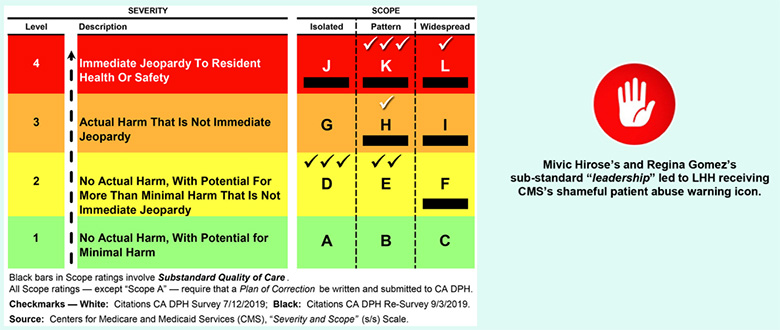
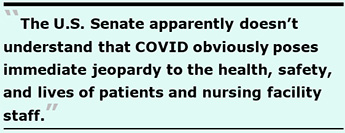 What’s completely inexplicable at this point is why SNF’s all over the country that are required to protect patients using effective infection control procedures may be being let off the hook simply because this virus is named COVID-19.
What’s completely inexplicable at this point is why SNF’s all over the country that are required to protect patients using effective infection control procedures may be being let off the hook simply because this virus is named COVID-19.
The U.S. Senate is reportedly considering granting broad immunity to hospitals and skilled nursing facilities in an additional COVID-relief federal funding package later this summer to protect facilities from COVID-related lawsuit liability. The U.S. Senate apparently doesn’t understand that COVID obviously poses immediate jeopardy to the health, safety, and lives of patients and nursing facility staff.
_________________________
1 As the Associated Press (AP) reported on July 7, although CMS has begun reporting facility-level data on COVID infections in each SNF nationwide, unfortunately the data is also incomplete. That’s because CMS allowed all nursing homes nationwide to choose between reporting their cumulative COVID case counts back to January 2020, or report their cases only back to just May 8 — two months after the pandemic had begun to take its toll. So, the CMS data contains apples-to-oranges data. It’s not known if CMS purposefully allowed SNF’s to chose for themselves which reporting periods they would submit, perhaps as part of President Trump’s desires and efforts to lower the case counts, which are politically embarrassing to him.
Obviously some facilities — such as the Life Care Center of Kirkland, WA — chose the later option to hide their initial COVID outbreaks. The news media have publicly reported the Kirkland facility had a cumulative total of 100 residents who had tested COVID-positive and 34 had died, but CMS’ web site reports that for the week ending June 21 the Life Care Center last reported to CMS that it had zero cumulative COVID patient infections and zero patient deaths.
The AP reports that Senator Chuck Grassley (R-IA) recently introduced legislation that would require nursing homes to report coronavirus cases and deaths going back to January 1. Grassley’s legislation reportedly has bipartisan support.
2 The moniker “moron” was bestowed on Trump by former Secretary of State Rex Tillerson, whom Trump had appointed but subsequently fired. There’s some debate on whether Tillerson had used “moron” or “f*#king moron.”